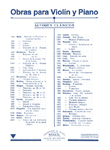WORKS
- Genre
-
Musical education
- Choir
- Counterpoint
- Dictation
- Direction
- Exam study manuals
- General music pedagogy
- Harmony
- Hearing
- Illustrations / Posters
- Improvisation / Sight reading
- Instrument methods
- Instrument pedagogy
- Instrumental study repertoire
- Instrumentation and orquestration
- Musical language
- Solfège
- Templates
- Theory and analysis
-
Incidental music
-
Lined paper
-
Flamenco
-
Religious music
-
Classical / contemporary
-
Modern music
-
Folk music / traditional
-
Musicology
-
Divulgation
-
Games and hobbies
-
Music therapy
-
Children / Youth
-
- Instruments
- Ensemble
- Difficulty level
- Period
- Genre
SOPORTE
Search
Find here: books, scores, composers, digital pieces, cd's
Best-selling works
Our classics
Newsletter
I wish to be informed of the news about your music
We have received your e-mail correctly
Multimedia
Davallament (x20)
Cantata de Nadal 2017 - vol. 13
Coro Mixto y Coro Infantil
CRUIXENT, FerranCRUIXENT, FerranCRUIXENT, FerranReg.: CN0025b
106,30 €
P.V.P. (VAT included 4%)
Add to cart
- Ensemble: Chamber orchestra: With voice/choir.
- Genres: Classical / contemporary: Chamber.
- Lyric author: SUSANNA, Àlex
- Language: Catalán
- Product format: Particellas
- Difficulty level: Advanced-superior
- Period: 2nd half S. XX - XXI
- Publishing house: Editorial Boileau
- Collection: Cantata de Nadal
- Measure: 31,00 x 23,00 cm
- Lenght: 17'
- ISMN: 979-0-3503-4077-2
- Available in digital: No
- Available for rent: No
Pack of 20 parts for choir
Davallament [Descent] for choir and orchestra is a one movement work inspired by the same catalan poem Davallament by Àlex Susanna, based on the Erill la Vall Descent from the Cross. Is a set of seven 12th-century wooden sculptures from the Pyrenees village of Erill la Vall in Catalonia, originally painted, comprising a complete Romanesque Descent from the Cross sculpture group, which in Catalonia has the peculiarity that it is made up of seven figures.
This musical work is specially written for Advent, in order to unify Nativity and Passion, an Oratorium for Eros and Thanatos.
To describe this dark premonition for Christmas, specific sound constellations are to be heard, starting with long, slow descending gliding tones (visions of suffering), with reminiscences of Gregorian Chants, hieratic harmonies and isorhythmic, perpetual and minimalistic structures inspired by this medieval period, long sequences in 3/4 to honour the holy Trinity, illusions, hope, scenes of spirits whispering Latin textes from beyond, as if the sculptures would predict their own destiny, scenes of penance, and the mystic ending that builds slowly from the dissonance a CMajor chord that represents the slow and painful construction of the human kind, referring to the meaning of the last strophe: «What could we have done to help avoiding this pain? », in colourful orchestral soundscapes according to Cruixent.
In the last passage Cruixent uses the cybersinging technique. Is has been developed by Ferran Cruixent in 2010 with the work Cyborg, which the musicians play sounds with their smartphones while they are playing their instruments. In this case we can hear bell sounds from Munich Cathedral.








